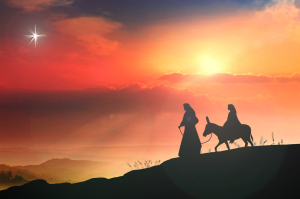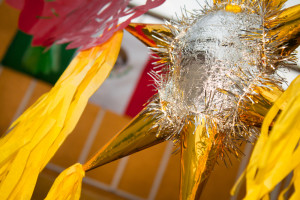For those not familiar with the Nativity story and the birth of Jesus Christ, I’ll be short, but essentially, the tale begins with Joseph and Mary, the parents of Jesus, having to travel to Bethlehem for the birth of their son as the result of a decree by Caesar Augustus for the purpose of running a population census. Once the two soon-to-be parents reached the birthplace of Joseph, where they were to have the child by law, they attempted to secure a room at an inn where they could be comfortable as Mary prepared to deliver her baby. However, each inn was filled to capacity and unable to provide a room for the married couple.
And from this story comes the celebration of Las Posadas….
Las Posadas in Mexico
Beginning on December 16th, the festival commemorates the journey of Mary and Joseph to Bethlehem and is celebrated in cities in towns across Mexico [1] and is celebrated until December 24th, with the nine days of festivities representing the nine months Mary carried Jesus in her womb, [2] although the significance of the nine days has also been questioned, which we’ll address shortly.
 While each celebration will vary depending on the region you are in, the likely similarities that a tourist would notice include a child dressed as an angel, two people, either children or adults, dressed as Mary and Joseph or carrying their images, as well as a procession of children followed by adults carrying candles. Recreating the couples’ arrival in Bethlehem, the procession will knock on previously selected doors where they sing Villancicos (Christmas Carols) and will ask for shelter, but are refused a roof, until they eventually reach their destination, which is either a preselected house where guests are treated to dinner and snacks [2] or a church where mass is held following the procession. [1] In either case, at the conclusion of the event, children will generally break open piñatas that are usually crafted in the form of a star and that are filled with candy and toys, while the last posada of the year is always followed by midnight mass and held on la Nochebuena, or Christmas Eve.
While each celebration will vary depending on the region you are in, the likely similarities that a tourist would notice include a child dressed as an angel, two people, either children or adults, dressed as Mary and Joseph or carrying their images, as well as a procession of children followed by adults carrying candles. Recreating the couples’ arrival in Bethlehem, the procession will knock on previously selected doors where they sing Villancicos (Christmas Carols) and will ask for shelter, but are refused a roof, until they eventually reach their destination, which is either a preselected house where guests are treated to dinner and snacks [2] or a church where mass is held following the procession. [1] In either case, at the conclusion of the event, children will generally break open piñatas that are usually crafted in the form of a star and that are filled with candy and toys, while the last posada of the year is always followed by midnight mass and held on la Nochebuena, or Christmas Eve.
The History of Las Posadas
Prior to 1578, the celebration of Las Posadas in Mexico did not exist, but was started by missionary Friar Diego de Soria in response to the Aztec tradition of honoring Huitzilopochtli, the war and sun god for the empire. [3] As the traditional celebration typically was held around the same time as Christmas, he wanted to establish a holy holiday that fell during the same time so that he could honor Jesus. [3] This is where the actual length of the celebration comes into question, however, because as many believe the nine nights to reflect Mary’s pregnancy, it also believed that Las Posadas was celebrated for nine nights because it lasted for the same duration as the festival for Huitzilopochtli, and this framework was used to adapt the celebration for Christian purposes. [4]
 Regardless of the reason for the nine days, the initial Las Posadas celebration was filled with pomp and circumstance to try and drive a greater amount of Aztecs to attend the ceremony and further evangelize the Christian message. The Friar was able to obtain a Papal Bull from Pope Sixtus V to celebrate his nine nights of mass, while also using sparklers, fireworks, Christmas Carols, and piñatas to further attract attention to the festival, which also highlighted various scenes from the Christmas story. [5]
Regardless of the reason for the nine days, the initial Las Posadas celebration was filled with pomp and circumstance to try and drive a greater amount of Aztecs to attend the ceremony and further evangelize the Christian message. The Friar was able to obtain a Papal Bull from Pope Sixtus V to celebrate his nine nights of mass, while also using sparklers, fireworks, Christmas Carols, and piñatas to further attract attention to the festival, which also highlighted various scenes from the Christmas story. [5]
Las Posadas in the United States
As Hispanic immigration increased, the traditions of Las Posadas expanded north as well. In Columbia, California, this year will mark the 32nd year that residents have celebrated the holiday. There, the Columbia State Historic Park is decorated in typical Christmas fashion with the boughs and wreaths, but what separates this event from the traditional festivities of Mexico is that the singing is provided by a costumed group known as the Mirth & Glee Carolers and instead of traveling from location to location looking for “lodging” the group marches along a crowd of participating onlookers. [6]
In Los Angeles, on Olvera Street, the procession takes place along the many stores on the street. Similar to the celebrations of Mexico, the festival-goers are denied entrance at the stores until they are finally admitted to a store and treated to complimentary champurrado and pan dulce. [4] And, of course, they always finish each night with a piñata, carrying out their tradition from the Mexican celebrations, and the first Las Pasadas festival from Friar Diego de Soria.
[1]https://www.britannica.com/topic/Las-Posadas[2]https://www.mexconnect.com/articles/2816-las-posadas
[3]https://www.dioslc.org/images/hispanic%20ministries/History%20of%20Las%20Posadas.pdf
[4]https://www.olvera-street.com/Calendar/Las-Posadas/las-posadas.html
[5]https://zedillo.presidencia.gob.mx/welcome/PAGES/culture/note_christmas.html
[6]https://www.visitcolumbiacalifornia.com/event/las-posadas-nativity-procession/








